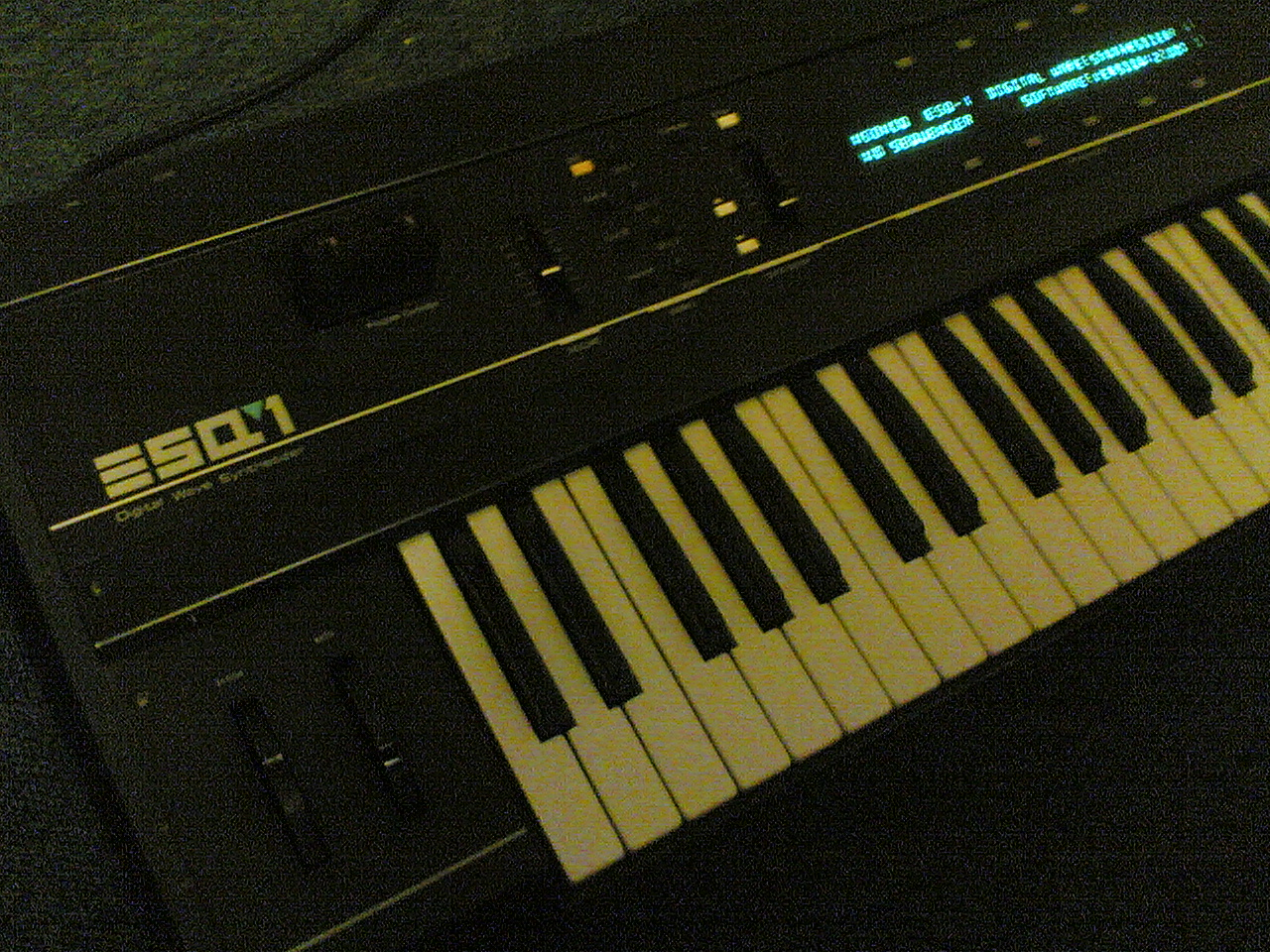- Ensoniq ESQ-1
Infobox_synthesizer

image_caption = A fully operational Ensoniq ESQ-1
synth_name = ESQ-1
synth_manufacturer =Ensoniq
synthesis_type = Analog Subtractive
polyphony = 8 voices
timbrality = 8
oscillator = 3 digital oscillators per voice
filter = 1 resonant low-pass per voice
attenuator = 4 VCA (3 DCA, 1 VCA)
Envelope - Four levels, four rates
lfo = 3 (triangle, saw, square and noise)
ext_control =MIDI
memory = 40 patches internal
80 extra with an expansion card
fx = None
dates = 1986 - 1988
price =
keyboard = 61 keysEnsoniq ESQ-1 is a hybrid digital-analog
synthesizer released byEnsoniq in 1986. The ESQ-1 featured 8 voices with 3 digital oscillators per voice. Each oscillator could be set to 1 of 32 different waveforms. Some of these were standard simple waveforms such as sawtooth and triangle, while others were samples such as piano and voice. Each oscillator also had an associated DCA (not VCA) to control its volume in 256 steps. In addition to that, an ESQ1's voice featured 3 LFOs, 4 envelope generators, a 4-pole resonant analoglowpass filter (VCF), and a final VCA with left/right panning. It also sported a 61-key velocity-sensitive keyboard, fullMIDI implementation, memory for 40patches , a memory cartridge slot, and an 8-tracksequencer . A rackmount version called the ESQ-M was also released circa 1987, with the exact same specification minus the sequencer. The ESQ-1 was produced until 1988.When the ESQ-1 was first produced it was marketed as an affordable workstation synthesizer and was a follow up to the earlier and relatively successful
Ensoniq Mirage sampler. Following the trend of many synthesizers in the early to mid 1980s it could be classed as an analog-digital hybrid - the oscillators and modulation matrix are fullydigital in nature whereas the filters were analog circuits. This enabled the ESQ-1 to sound like an analog synthesizer while at the same time reaping the benefits usually associated with digitally controlled parts, such as patch memories and the extreme stability of the oscillators, therefore making the ESQ-1 impervious to the infamous tuning problems that could be experienced with true analog synthesizers.The 32
waveforms enabled the ESQ-1 to cover quite a lot of ground sonically. It also had a wealth ofmodulation possibilities with its three LFOs and four envelope generators, which were not of the typicalADSR variety but featured a more versatile level/rate model instead: each envelope therefore contains eight controls -- four levels and four rates, allowing both positive and negative values. The fourth envelope is hard-wired to control the amplitudes of all oscillators the after they have been mixed together.Another digital trait of the synthesizer was apparent at first glance -- it has no knobs whatsoever, and only two faders, one of which being the volume slider. Thus all of the programming was handled by many "soft" buttons and one data slider that controlled the selected
parameter . This approach to programming was very similar to that of theYamaha DX7 , at that time the most popular digital synthesizer of all, and is very different from having a dedicated control for each of the parameters. However, every internal module (all the envelopes, VCAs, filter, oscillators) have dedicated selection buttons, so you will never have to scroll through parameters to find what you want.The ESQ-1 has a distinct sound, although the machine itself was overshadowed by other keyboards of the eighties, mainly other digitals like the
Yamaha DX7 ,Roland D-50 andKorg M1 to name a few. The waveforms ofsampled sounds do not produce realistic results by today's standards, but can be useful for creating patches containing hints of the instruments that they were intended to emulate. Also the inclusion ofAmplitude Modulation and Oscillator Hard Sync strengthened its ability to emulate other analog synthesizers.External links
* [http://www.buchty.net/ensoniq/ Rainer Buchty's Ensoniq Heaven (support community), including a VST emulator of the machine]
* [http://www.pic101.com/ensoniq/ ESQ Hacker Page - Detailed ESQ repair and FAQ page]
Wikimedia Foundation. 2010.
